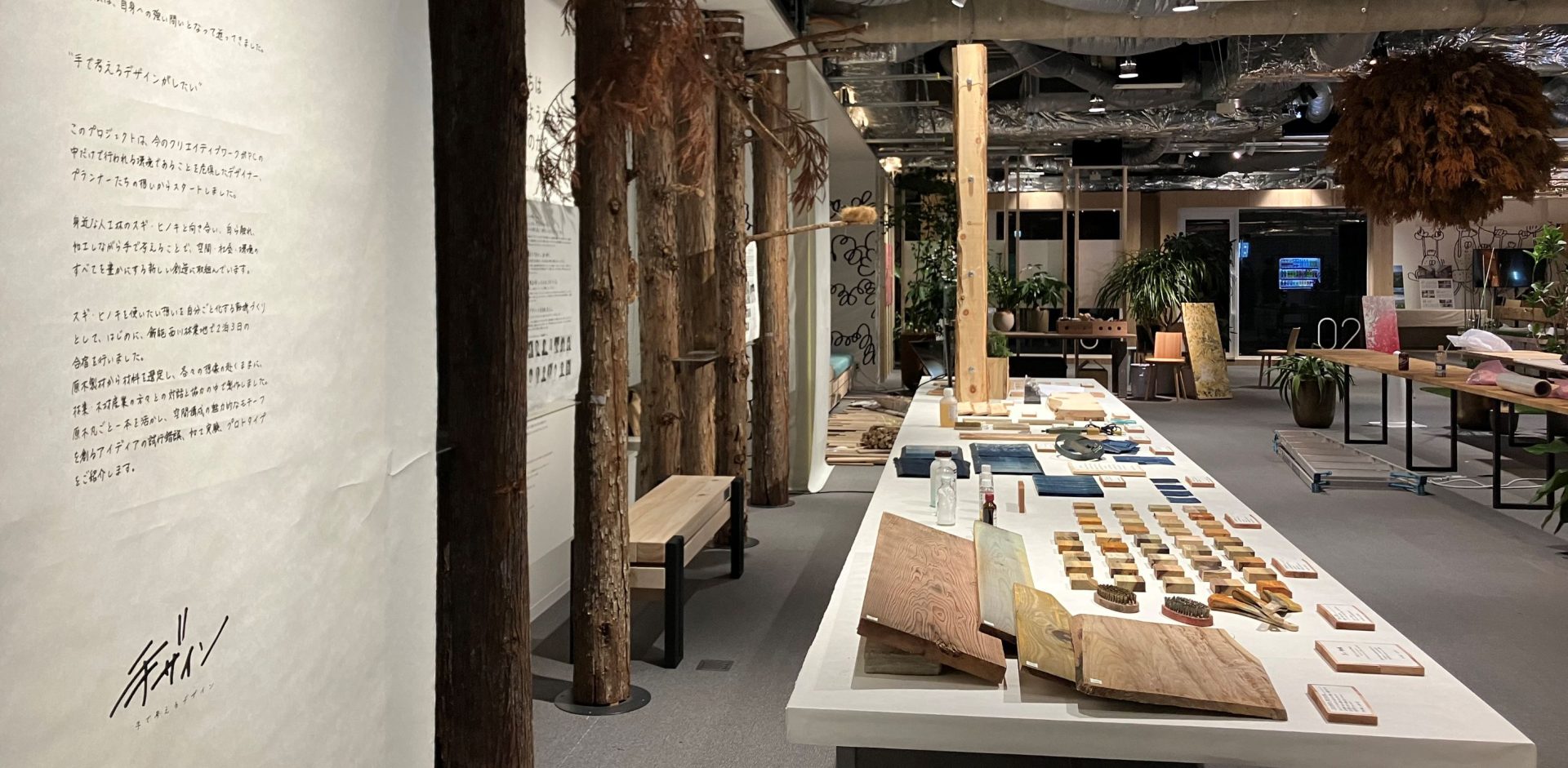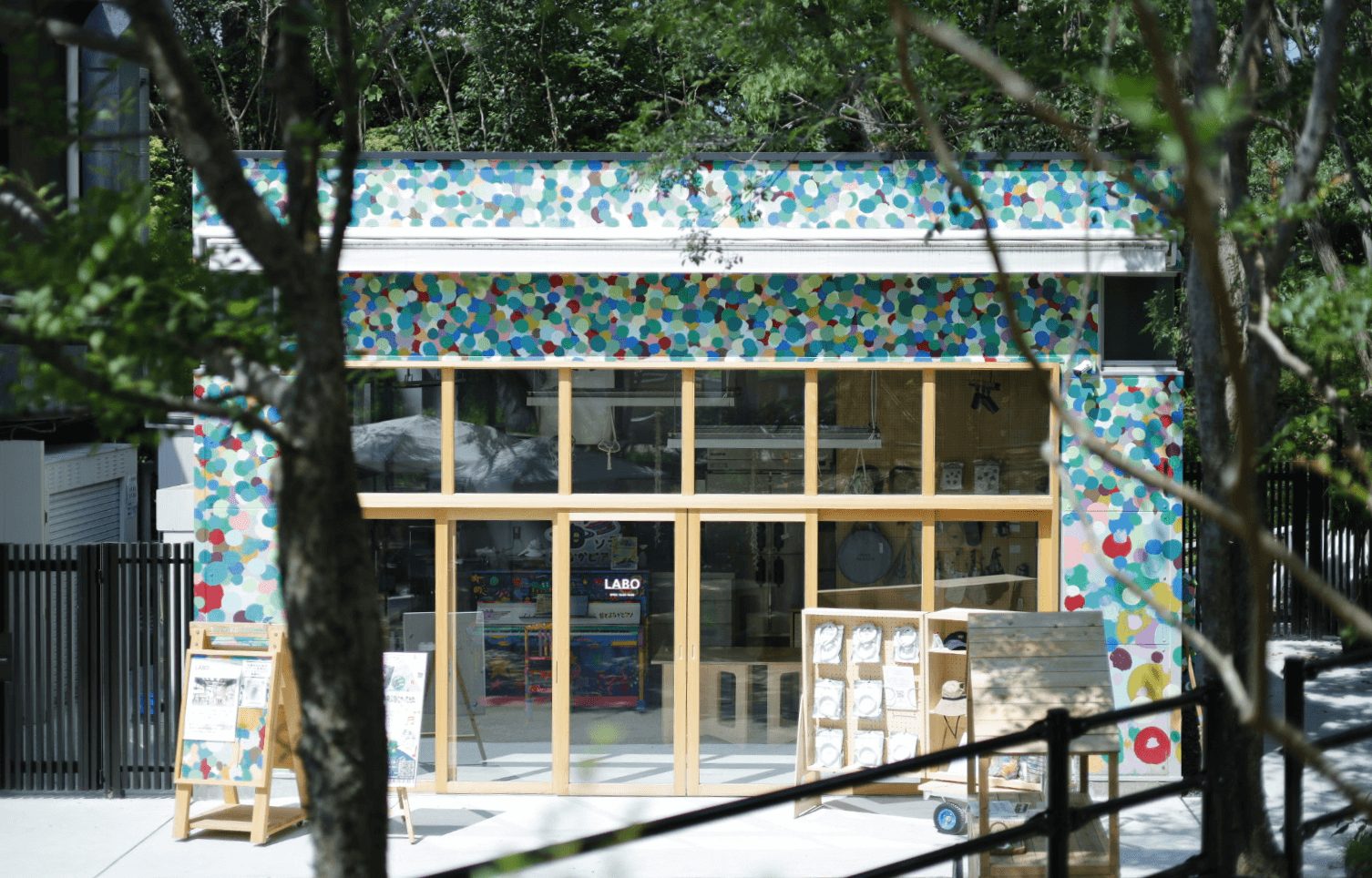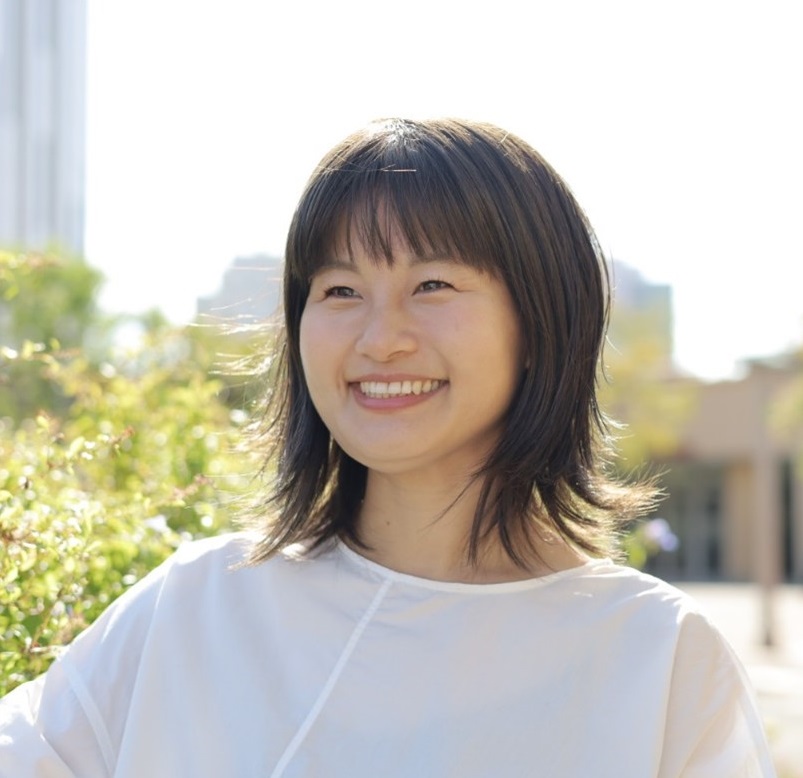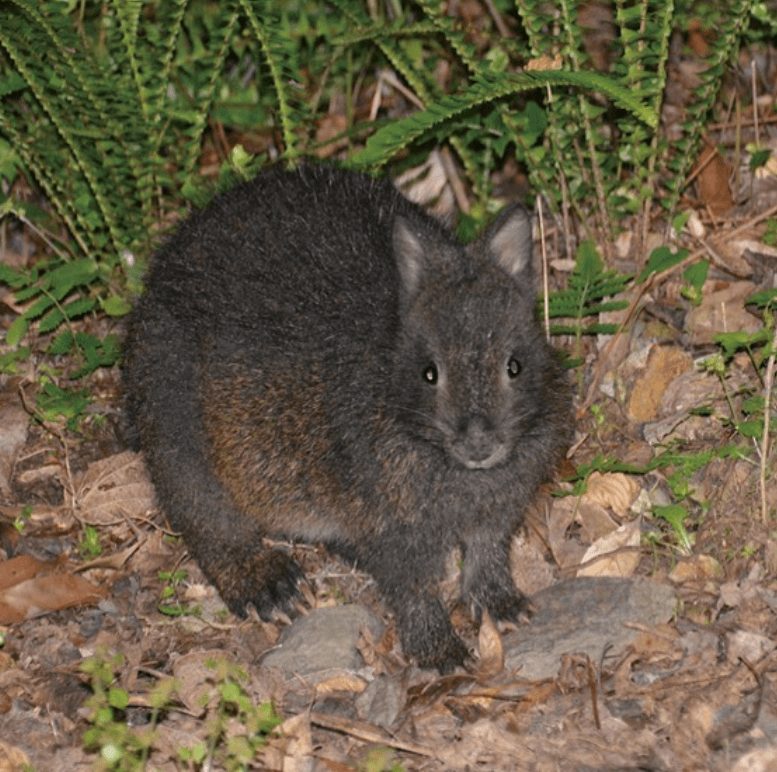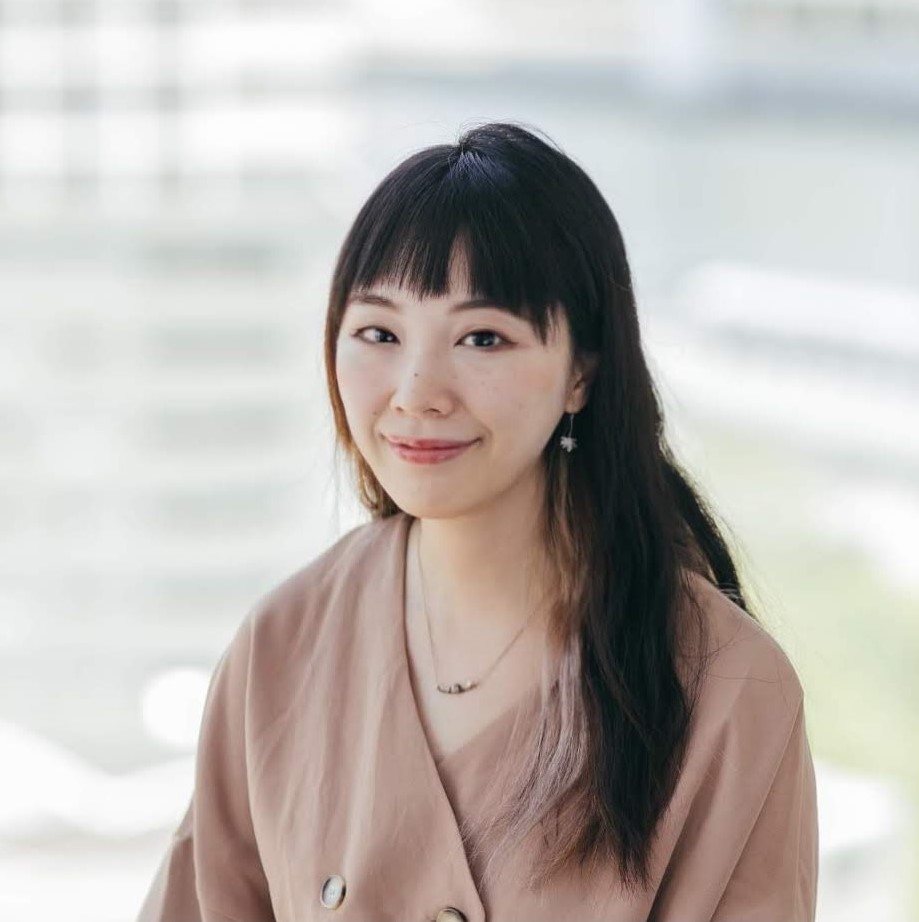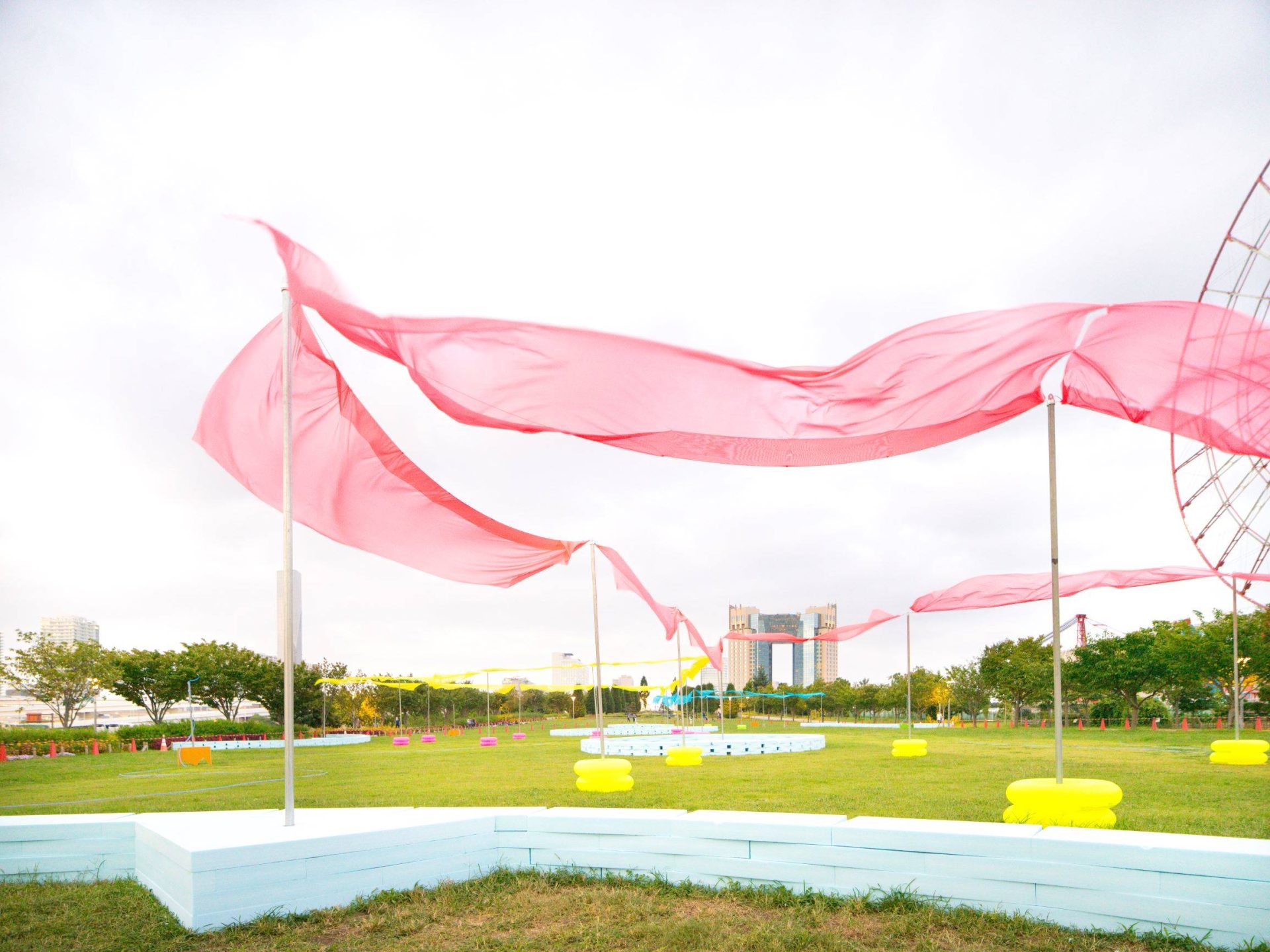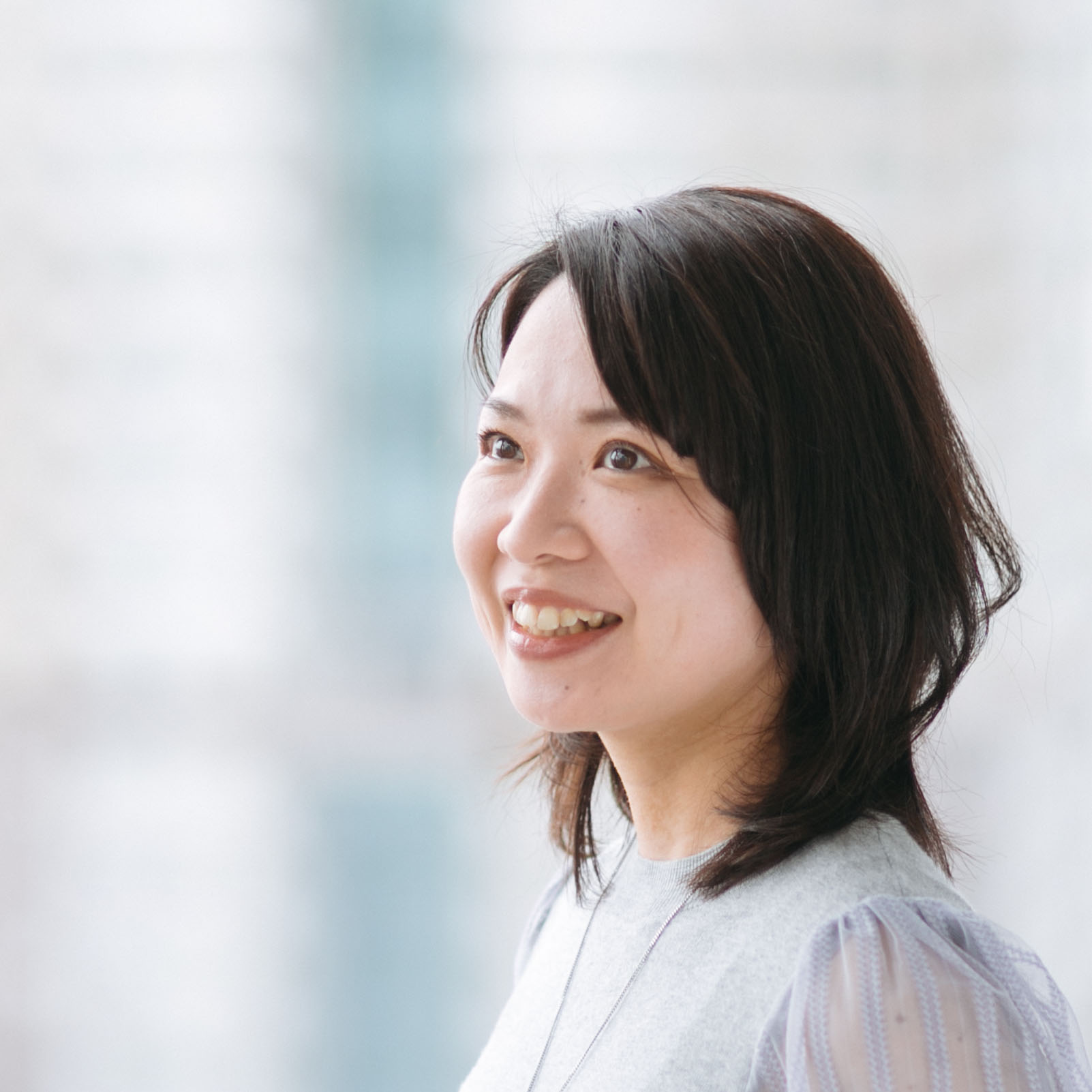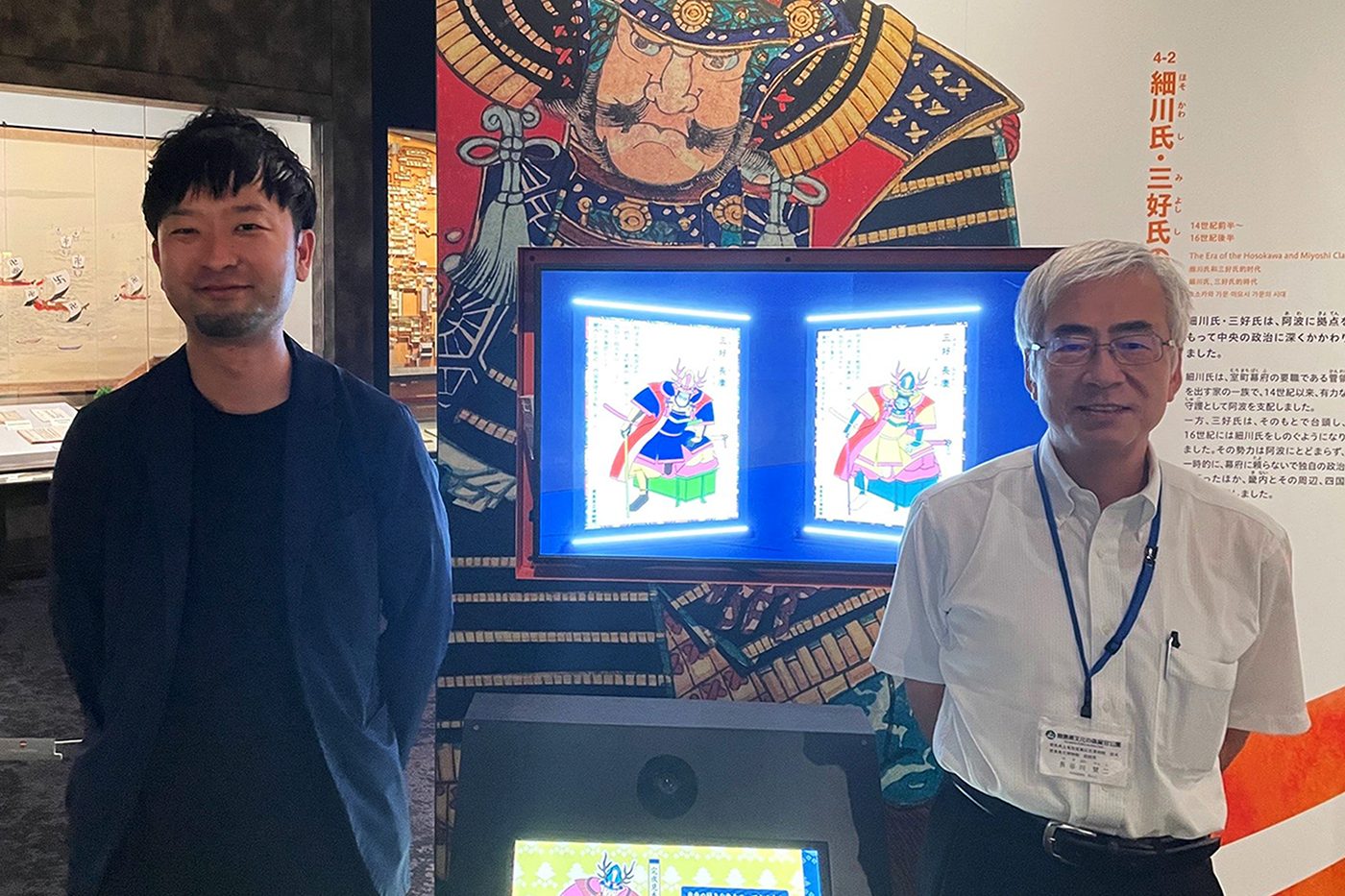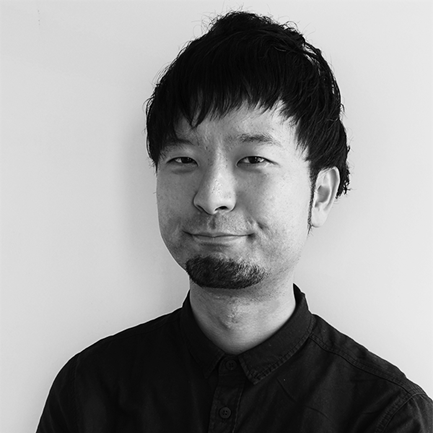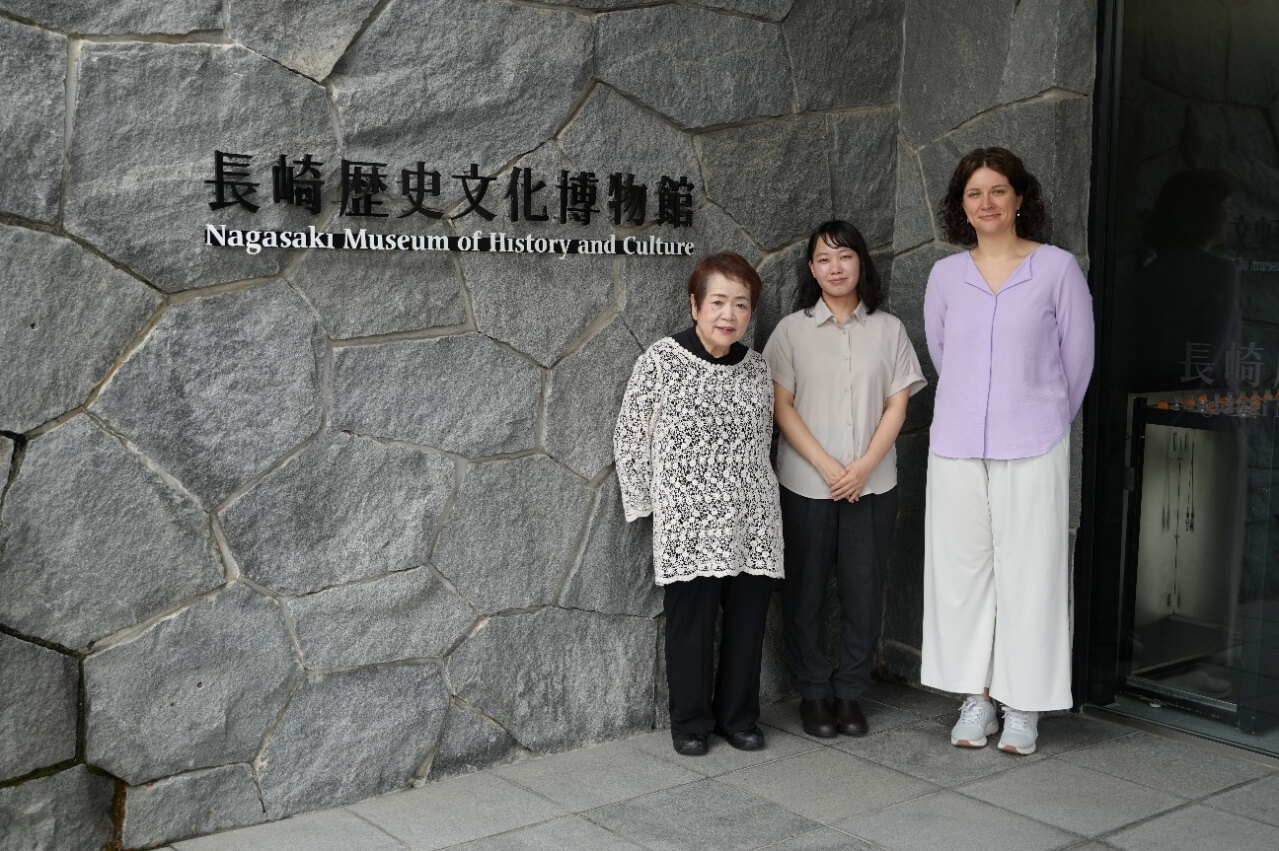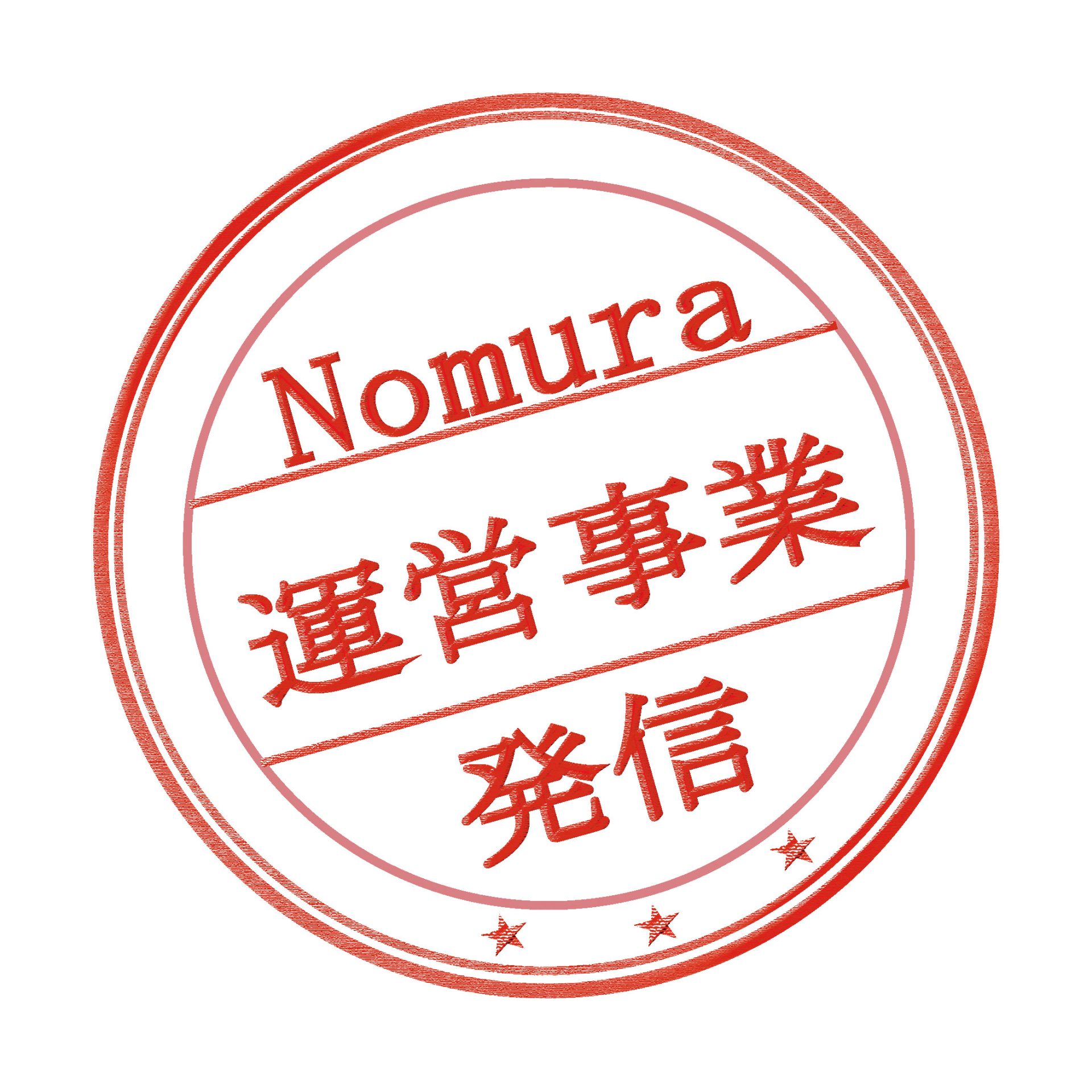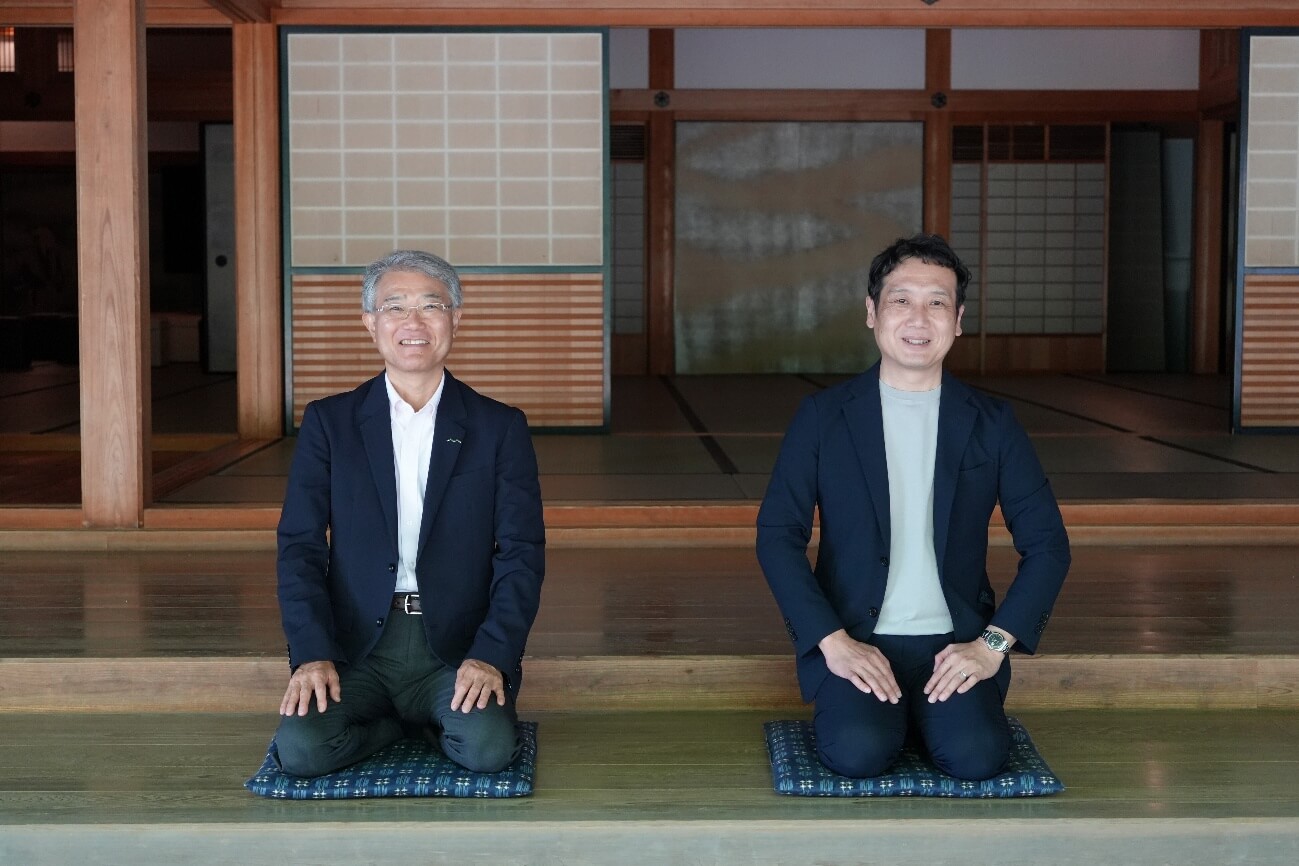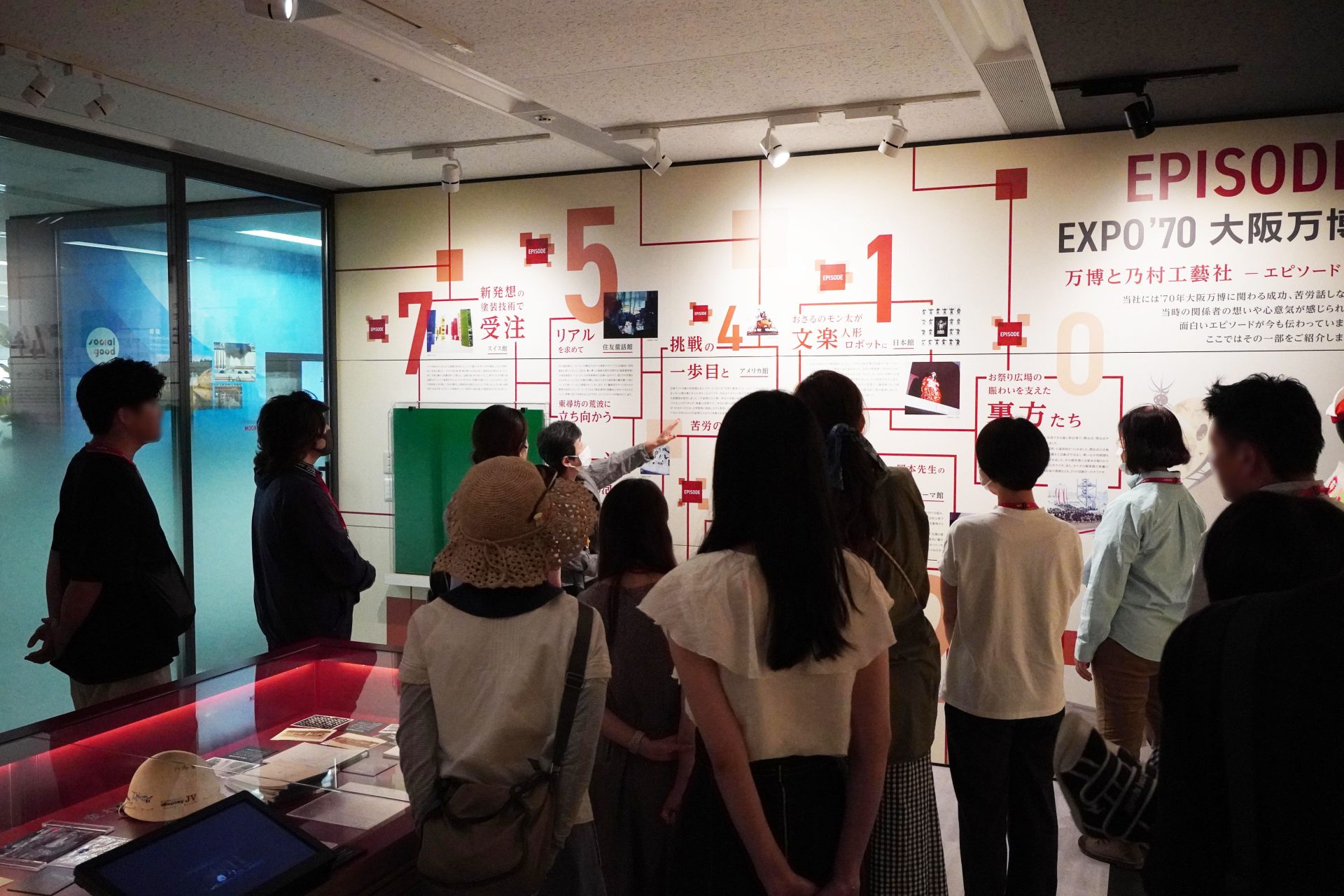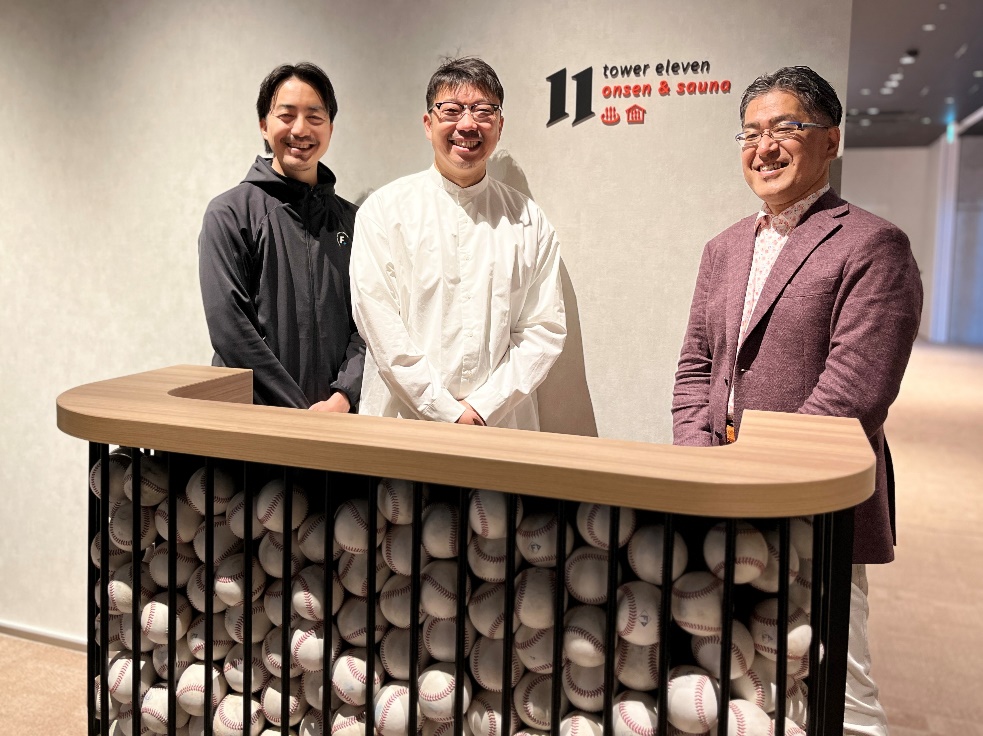- text and edit by
- ノムログ編集部
過去にお城展示を担当された文化系プランナーによる対談です。
ご自身が携わった「お城展示」について、文化プランナー4名で語り合っていただきました。
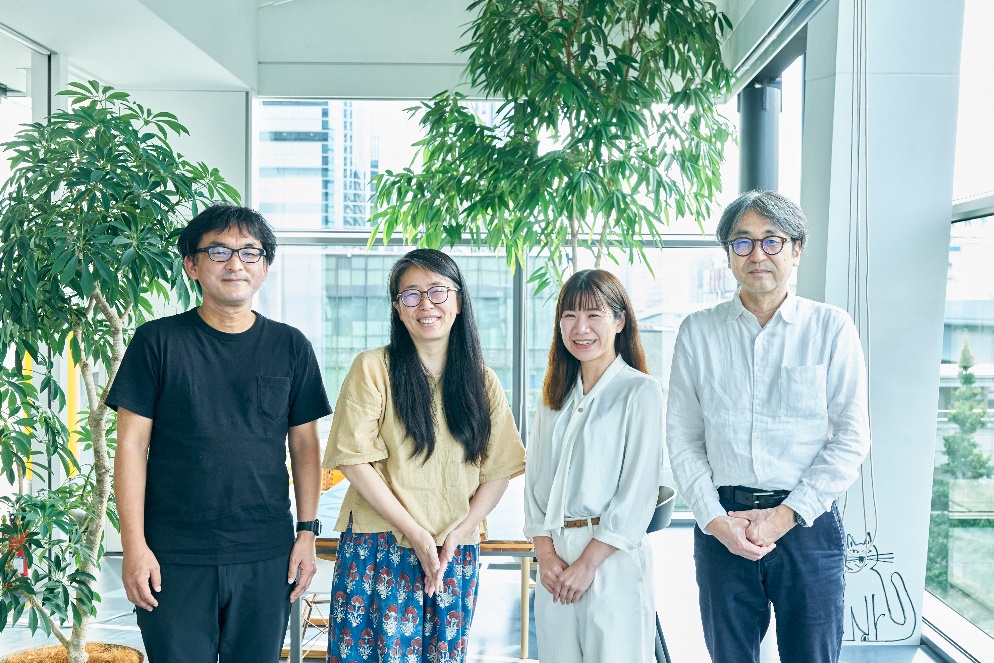
〈左から〉森誠一朗さん(岡山城)、稲垣美麻さん(浜松城)、嵩恵奈さん(駿府城東御門・巽櫓)、吉田雅之さん(会津鶴ヶ城)
城好きプランナー4名のプロフィールとお城展示について思うこと
〈対談者プロフィール〉
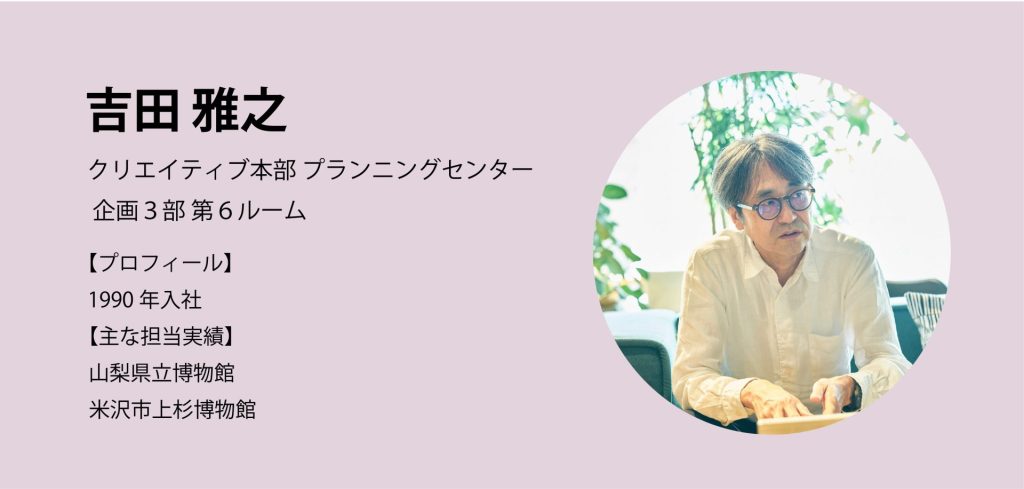
A. あなたが思う、「お城展示のおもしろさ」とは?
展示とお城での体験が同時に楽しめる点です。展示展開される世界と、その場に身を置き、当時の人と同じ目線に立てる、ヒューマンスケールの世界とをいったり来たりできることです。
B. お城愛を語ってください!
どんなかたちであれ、かつてその場所にはお城が存在していた、と言う事実そのものが愛おしいです。そして、天守閣や遺構、遺物があろうが、なかろうが、お城であれやこれや妄想するのが何より楽しいです。
C. お城展示のこれから
やはり、可能な限り資料を公開する展示がしたいです。城下町を中心とした地域の歴史的変遷が感じとれる、お城と現在のまちとのつながりが感じられる展示です。天守閣からまちを眺めた時のように、お城からあれやこれやと地域への興味が高まる展示をつくりたいです。
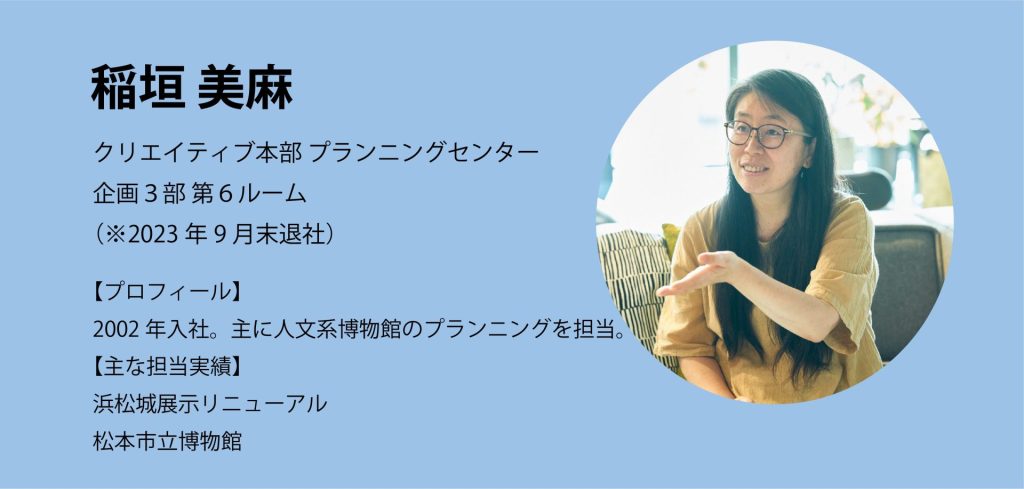
A. あなたが思う、「お城展示のおもしろさ」とは?
お城は400年も500年も前のままの場所にある要塞だということが、固有の特徴かなーと思います。目的がはっきりしている。だから当時のその土地の位置づけを現在でも想像可能なのがおもしろいところだと思っていて、その入り口づくりができるところが展示のおもしろさかなと思います。
個人的には、武将はいっぱいいすぎて、情報過多でめんどくさい。ので、地形とかから入る方がハードルが低いです。
というわけで、城展示で好きなのは、定番ですが、地形にプロジェクションマッピングで、城の成り立ちとか、隣国との関係を説明したやつ。大河ドラマで最近はマップ解説を重要視しているようですが、あれをもっと突き詰めたい。
B. お城愛を語ってください!
城マニアではないので、城の好きなところは最上層の眺めです。あとは城の入り口までのいろいろなアプローチ。高知城の複雑な石垣の眺めとか、熊本城の石垣のカーブとか。
C. お城展示のこれから
縄張りが気になる。更地にどう築城するか、その設計図を作るまでにどんな試行錯誤があるか。同じ土地でも縄張りの仕方は人により違うと思う。そんなことをワークショップでいろいろなありかたを考えて、展示化してみたいなと思う。その土地のポテンシャルがわかると思うし、なぜこの城だったか実感できるんじゃないかなーと思う。自分的には城ゲームを少し攻略してから城展示に臨みたかった。
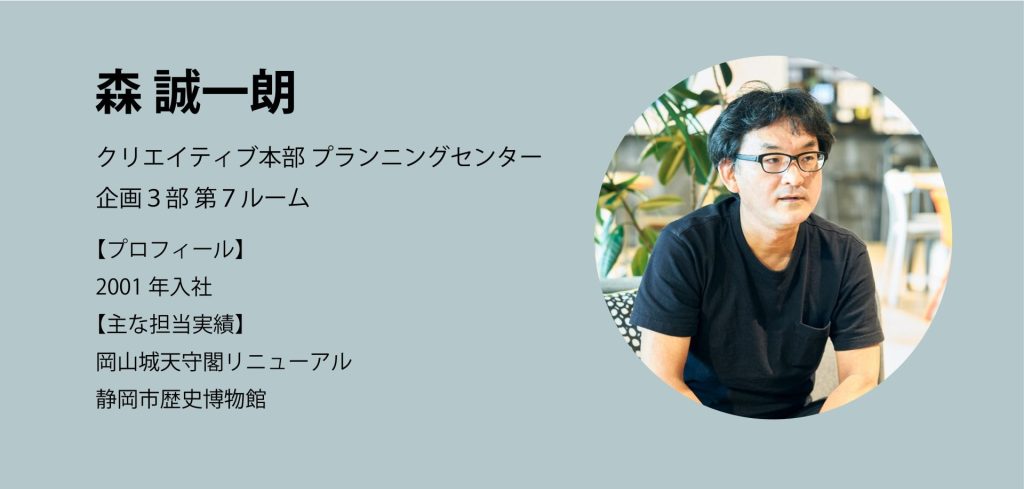
A. あなたが思う、「お城展示のおもしろさ」とは?
お城という歴史的な場所(実際は復元された天守閣であることが多いが) そのものを活用して展示できること。また、人間ドラマを感じられるような話題も多いです。
B. お城愛を語ってください!
日本全国にたくさんあり、当地の自然地形などを活かしたお城も多く、背景などを知ることで、より深く理解できたり、納得できたりできる(=勉強のしがいがある)こと。
山城では、何気なく見ると山の斜面にしか見えない場所に人の営為の痕跡(堀など)を見つける楽しさがあります。
C. お城展示のこれから
岡山城でもチャレンジしたが、男性目線だけではない展示(女性や子供)や外国人にも理解できる展示など、幅広い人が地域の歴史に興味をもつ入り口として、今よりもさらにお城展示が活躍できると良いと思います。
また、天守から眺めると築城当時の眺望が見られたり、当時の戦いが見られるような、AR展示を手掛けてみたいです。
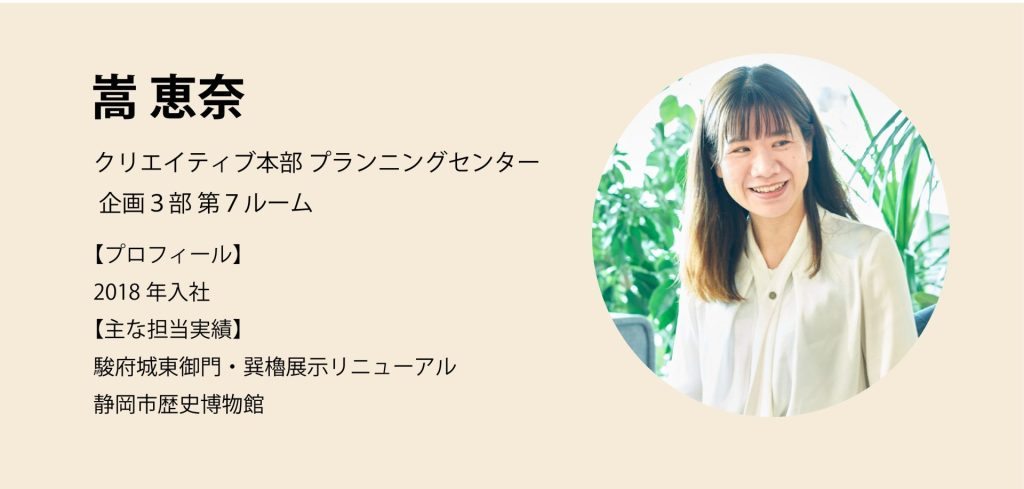
A. あなたが思う、「お城展示のおもしろさ」とは?
昔の為政者に関する内容が多いが、そこから現代まで地域に息づく暮らしや文化を垣間見ることができる点。城とまちは地続き。
B. お城愛を語ってください!
【私のお城の楽しみ方】
お城(跡)から見渡すまちの風景から、当時の城主の気持ちに思いを馳せる。
C. お城展示のこれから
城の中にカフェがあったり、あそび場があったりと、地域の人が気軽に訪れて、通いたくなるようなお城の活用。
皆で日本城郭検定を受験
本日はよろしくお願いいたします。
小耳に挟んだのですが、皆さん日本城郭検定を受検されたご経験があるそうですね!
稲垣
はい。森さんからお声がけいただいて、今日参加しているメンバーと他の数人で受けました。
森
みんなでいきなり2級からチャレンジしたのですが、なかなか難しかったです(笑)。
嵩
ちょうどコロナ禍になった頃でしたね。
稲垣
受検時には、オンライン勉強会を開催したり、お城に精通しているプランナーから話を聞いたりして、みんなで対策しました。
稲垣
1時間半だけ時間を取って、毎週やっていましたね。
自主学習するより、みんなで時間決めて集中して勉強するのがすごくよかった!試験の時も、みんなで話しながら勉強した所はしっかり思い出せました。
会津鶴ヶ城での展示
それではまず、吉田さんがご担当された会津鶴ヶ城についてお話をうかがいたいと思います。
「ずいぶん前のお仕事」とおっしゃっていましたが、何年前に担当されたんですか?
吉田
改装に携わったのは、もう20年くらい前です。今年、展示が更にリニューアルされていますので、私が手掛けた展示はもう見られないのですが、当時のことを思い出しながらお話します。
私が担当した会津鶴ヶ城のお仕事は、天守閣内部の展示をリニューアルする、というものでした。
会津鶴ヶ城は、江戸時代以前に城主が何回も変わっているので、その事実について説明する必要がありました。
展示内容は、地下から天守閣の最上階に行くまでに、お城の話だけではなく、城下の暮らしや文化についても展開する構成で、お城の中で、会津の歴史や民俗・文化についてふれられる構成です。
現在のお城は昭和40年に鉄筋コンクリートで外観復元された建物です。天守閣がオリジナルの場合、木造であることや、文化財指定されていることなどにより、展示をする場合に制約がかかってしまいますが、鉄筋コンクリート造では動線と空間を十分に確保して展示を構成することが可能でした。
会津鶴ヶ城の展示の見どころを教えてください。
吉田
当時私は、『京都守護職始末』、『会津戊辰戦史』、『ある明治人の記録』などを読んでいましたが、会津ならではの展示を!という想いが強く、ふさわしい資料の展示について積極的に提案しました。
例えば、孝明天皇の御宸翰(ごしんかん)*1の紹介です。当時天皇が松平容保をいかに信頼していたのかがよくわかる文書です。
*1 宸翰(しんかん):天皇や上皇の自筆の文書。
展示する資料はどのように最終決定したのでしょうか?
吉田
市や財団、監修の先生のチェックを経て、最終決定しました。
会津鶴ヶ城は現在でも盛況ですが、リニューアル直後の現場はどんな感じだったのでしょうか?
吉田
観光地なので、お城は目玉ですよね。改装直後のゴールデンウイークは、何万人もの入館者が訪れたそうで、大好評だったようです。
浜松城での展示
では次に、家康ゆかりの浜松城を担当された稲垣さん。浜松城展示の自慢ポイントを教えてください。
稲垣
浜松城の自慢は、石垣が築城当時のものであることです。天守閣の建物自体は復元されたものですが、家康が生きていた頃の石垣がそのまま残っています。
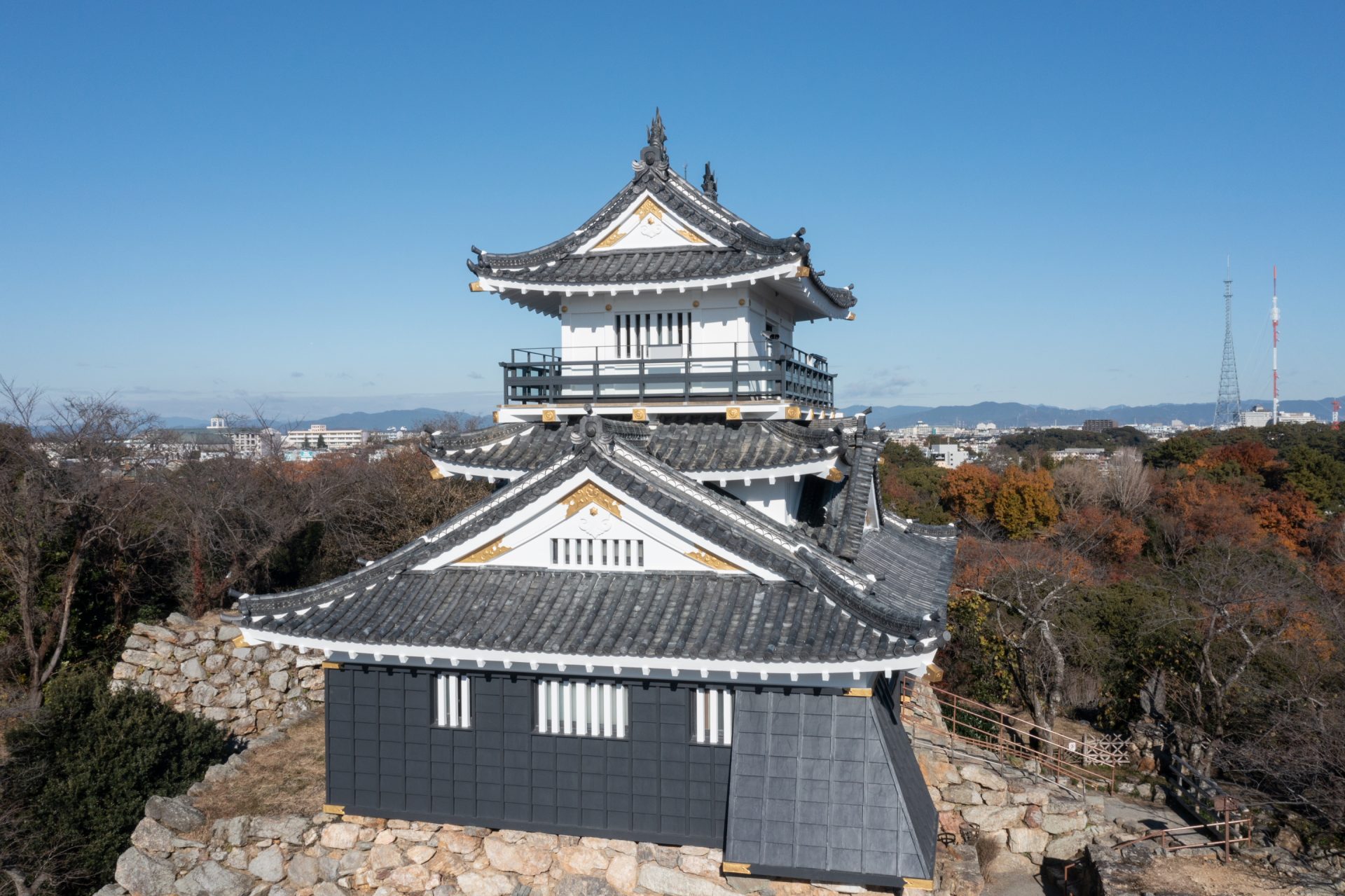
🄫浜松市
稲垣
浜松城は三層の小規模な天守閣で展示を構成していて、一層目は家康という人そのものを伝えるエリアです。
浜松市さんが制作していた家康の「生き人形」を中心に、映像コンテンツや甲冑のレプリカを展示しています。
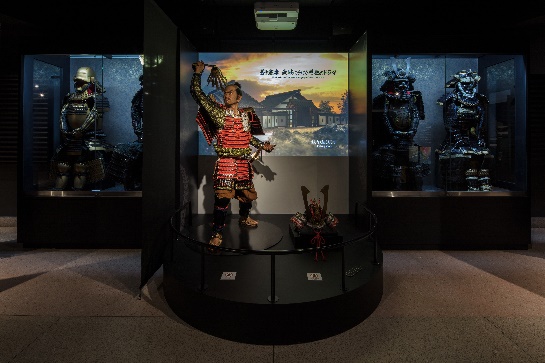
🄫浜松市
先日見学したのですが、人形が本当に印象的でした。
自分の知っている家康像と全然違っていて、意外と華奢で凛々しい姿を見てびっくりしました。
稲垣
そうなんです。一般的な家康のイメージである「たぬきおやじ感」を払拭し、若くて血気盛んなダメダメ家康を推していこう、というのがそもそもの展示企画の始まりでした。
だから、家康の大河ドラマでの取り上げられ方をみて、「まさか」と思いました。青年期にもフォーカスしている点で、浜松城の展示の考え方と通じるところがあります。
ちなみに、浜松城も会津鶴ヶ城と同様に、戦後に建てられた鉄筋コンクリート造の復興天守なので、展示リニューアルはしやすかったです。
人形以外の展示の推しポイントもぜひ教えてください。
稲垣
実際に現地で発掘調査を行っているので、家康の時代の石垣がどこまで広がっていたかという浜松市の研究成果を展示できたことも大きかったです。
また、30年くらい前に制作された既存のジオラマを活用した展示エリアがあります。
このジオラマでは、家康の時代から江戸時代に拡張した城の縄張りと城下町の広がりをプロジェクションマッピングで表現しました。
30年前の制作当時に作られた図面集が残っていたおかげで、プロジェクションマッピングの映像をジオラマに載せた時、映像と模型の位置がぴったり合ったことにびっくりしました。学術検証しながら作成した図面だったようです。
ものづくりする時は、細かい寸法を合わせるために現場で微調整するので、最終形態の模型と図面の寸法がぴったりあうのはあまりないことなのです。
だから、最終的な形として残してくれていたことに感動しました。地形や厩(うまや)の作り方など、制作当時の方たちの几帳面さが伝わってきました。
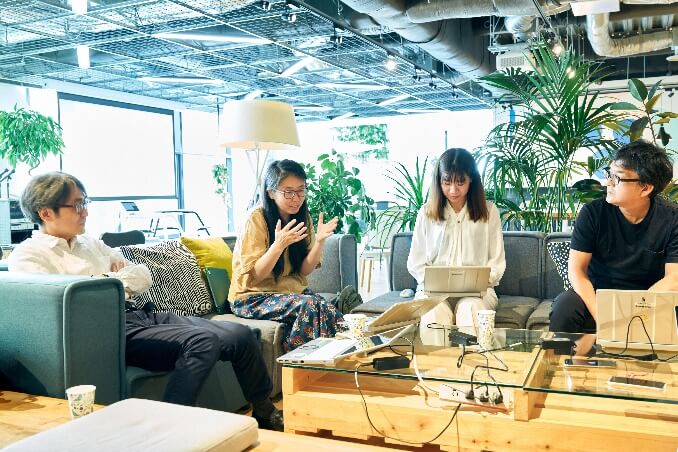
最上階はどうでしょうか?
稲垣
最上階の三層目の天井には、歴代城主の家紋を展示しています。ちなみに浜松城は出世城と呼ばれており、城主を務めた武将たちは去ったあと幕府の重役に就くことが多かったようです。
駿府城での展示
嵩さんが展示企画を担当された駿府城の東御門・巽櫓も、家康ゆかりの場所ですよね。
嵩
はい。家康は生涯で幼少期から3度静岡に住んでいたのですが、その間、駿府城を2度築城しました。駿府城は、静岡市葵区、静岡駅から徒歩15分ほどの位置にあります。
私が展示リニューアルを担当した東御門(ひがしごもん)と巽櫓(たつみやぐら)は、それぞれ平成元年と8年に復元されました。
静岡市が進めていた「歴史文化の拠点づくり」の事業のひとつである「静岡市歴史博物館」の付随施設として、静岡市の歴史観光の拠点となることを目的に整備されました。実際に、令和5年1月にオープンした静岡市歴史博物館や大河ドラマの影響もあり、東御門・巽櫓を含め周辺施設の回遊が増えているそうです。
駿府城の特徴は、ズバリどんなところでしょうか。
嵩
まずは、天守のスケール感です。
平成28年から、公園内で石垣の遺跡発掘調査が行われ、天守台の大きさが西辺約69メートル、北辺約63メートルであることが明らかになりました。これは、江戸城の天守台よりひと回り大きいサイズで、日本で一番大きな天守台と言われています。
もうひとつは、一地点で全時代を語れることです。このエリアには古代から人が住み続け、奈良時代から平安時代の初め頃にかけては、役所に関連する場所であったと推測され、政治的に重要な場所でした。そして戦国時代になると、今川氏が治めた地と同じ地域内に駿府城が築かれました。つまり、ここ駿府城は静岡の歴史をひとつに圧縮した場所と言えるのです。
そういった駿府城のすごさを解剖し、地域の歴史をずっと見てきたお城の一生を伝えることで、静岡の歴史がわかるようにしたいという想いのもと、展示を企画しました。担当デザイナーさんとスケッチを描き合い、漫画でアイディアを出し合いました。
吉田
すごい、みなさん絵がお上手ですね!
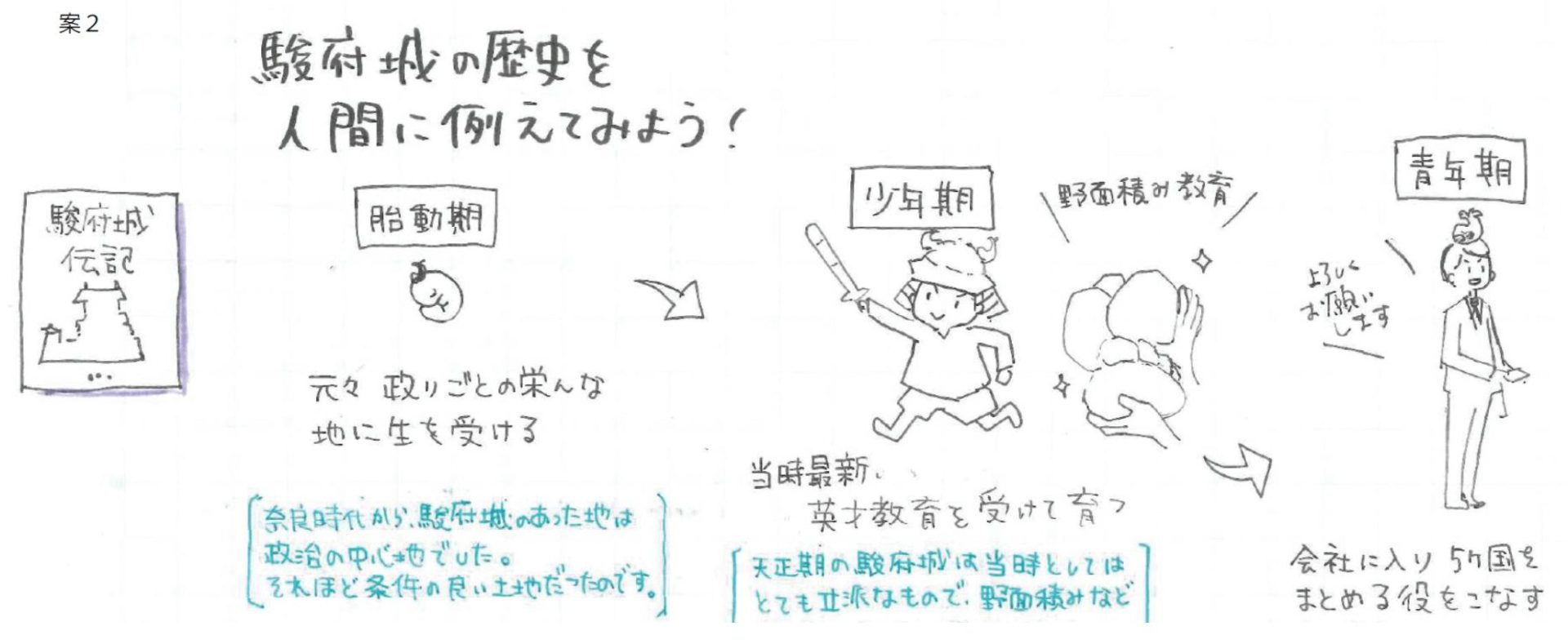

嵩
最終的には、「駿府城の一生を振り返ろう」というグラフィックになりました。
吉田
おふたりのスケッチの案が活きていますね!
稲垣
「駿府城の一生を振り返ろう」の案に対する、お客さんの反応は?
嵩
「お城を擬人化するという視点が面白い」とおっしゃっていました。
吉田
お城を擬人化したときに、人の年齢に例えるのは難しそうです。
嵩
駿府城のすごさを伝える展示では、「駿府城大解剖」というコーナーをつくりました。
ここでは、5W1Hで駿府城のプロフィールを紹介しています。キャッチフレーズでお城をわかりやすく伝えると同時に、解説グラフィックとちょっとした体験展示を添えています。
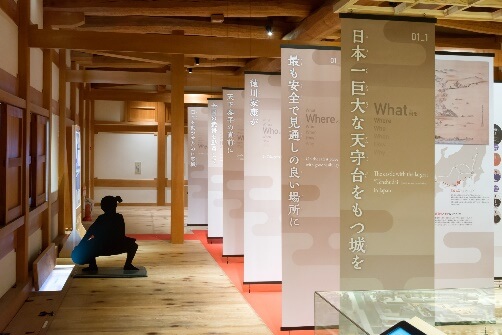
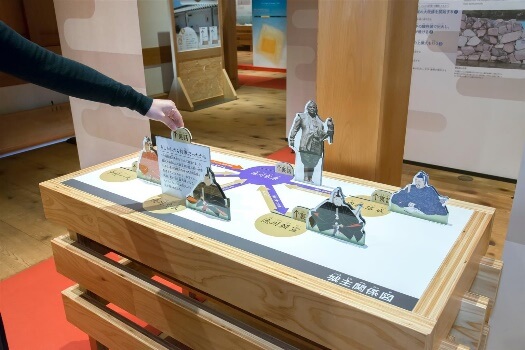
吉田
ジオラマもすごいですね。映像コンテンツもあるのですね。
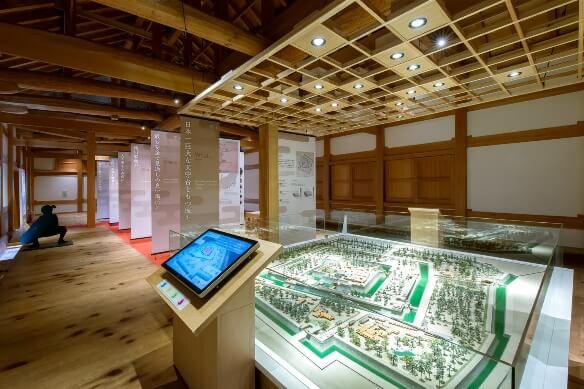
嵩
子どもたちにも親しんでもらえるように、ハンズオンも取り入れました。石垣の刻印*2スタンプ体験ワークシートやめくりクイズなど、子どもでも楽しんで学ぶことができると好評のようです。
*2 刻印(こくいん):石垣に使われている石材に刻み込まれている様々な文字・記号。石垣工事に携わった大名の家紋、石積み職人のサイン、石材の産地などを記したものであるとされている。
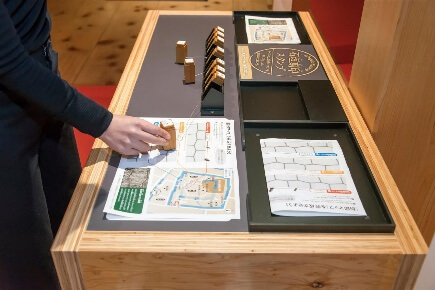
嵩
「これからの駿府城」というコーナーでは、今のお城の周辺情報も発信でき、周辺地域への回遊を促す空間にしました。
吉田
実物資料の展示はありますか?
嵩
はい、あります。青銅製の鯱(しゃちほこ)や城で使用されていた食器類などを展示しています。
吉田
やはり実物の資料が展示されていると納得感がありますね。体験ばかりに寄りすぎると、城マニアは不安な気持ちになります。
吉田
後ろのグラフィックはバナーを吊っていますね。
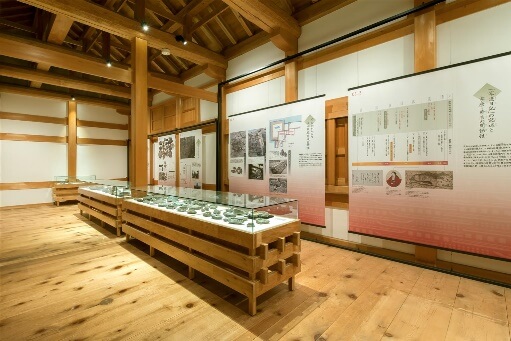
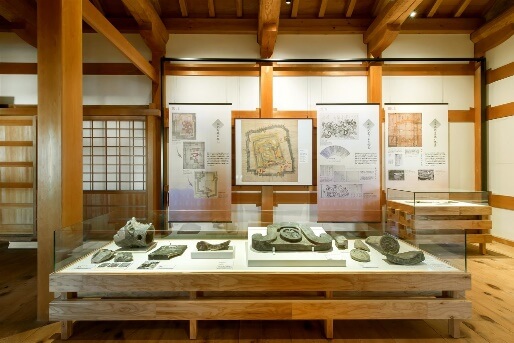
森
木造で復元された建物を極力傷めないように配慮しました。
また、建物の空間がきちんと見られるように、展示造作で壁を立てるのではなく吊り式のバナーを採用しました。ちなみに床は板張りや畳敷きで、土足・スリッパ厳禁です。
岡山城での展示
子どもたちやお城初学者からマニアまで楽しめるのが良いですね。
森さんが担当された岡山城について、教えてください。
森
岡山城は、関ケ原では西軍の大将格として活躍した宇喜多秀家の父・直家が築いたお城です。「烏城(うじょう)」と呼ばれるほど黒い天守が特徴です。
また、多くのお城の平面は四角形ですが、岡山城は「不等辺五角形」になっています。
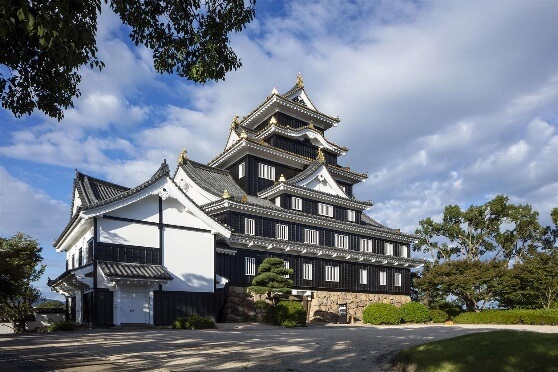
さらに、天守閣は通常、武器庫などに使われたと言われていますが、岡山城には「城主の間」という藩主の部屋があります。
かなりユニークなお城ですね。
森
岡山城は、第二次世界大戦の空襲で焼失し、戦後復元されました。ほかのお城では想像で復元したものもありますが、岡山城は後に建築家として活躍する方が学生時代に作成した焼失前の実測図が残っているなど、図面資料も多く、比較的正確な復元であると言われています。
展示の手法における特徴はありますか。
森
岡山市出身の歴史学者の先生に全面的に監修いただきました。
ほかにも市から「女性の視点も入れたい」という要望があり、歴代藩主を、妻が亭主を自慢する形で紹介する方法を考案しました。今後の歴史展示でも、女性視点というのは大切になってくると感じました。
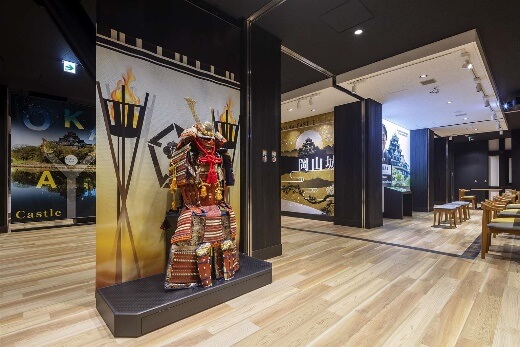
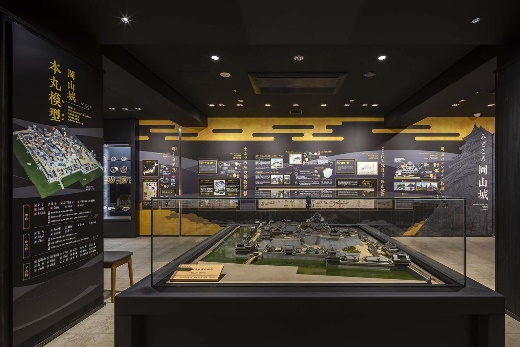
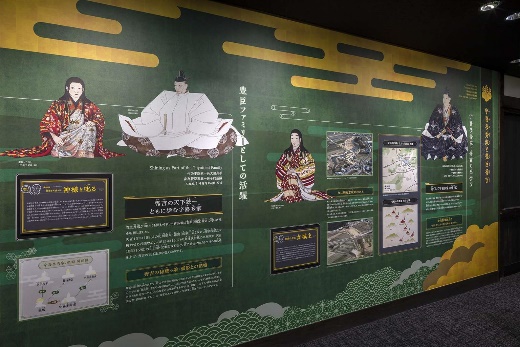
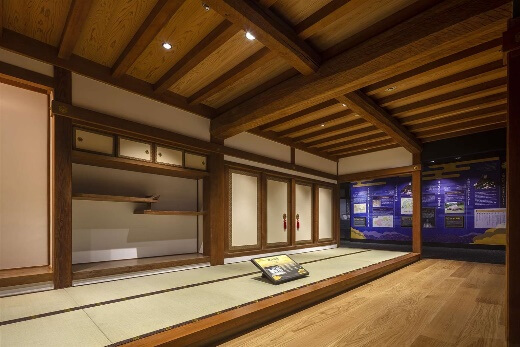
また、監修者の先生から岡山在住の忍者の記録があるというお話を伺い、岡山の忍者コーナーも設けました。
歴史展示では「諸説あり」の部分が出てきますが、どのように対応されましたか?
吉田
会津鶴ヶ城では、市や学芸員、監修者の意見を踏まえつつ、展示側の意見も推しました。最終的な判断は監修者ですが、展示の文脈や資料が持っている特性を理解したうえで企画者なりの案を、アウトプットの方法とともに推すことは大事だと思います。
森
諸説があること自体がおもしろいと思います。岡山城では、監修の先生独自の見解として語っていただいた内容を解説パネルにしました。
吉田
地域ごとに固有名詞の呼称などについて、言い方を検討する必要がありますね。例えば、会津鶴ヶ城の展示では、ご当地や県民感情をベースに言い方を変えました。
稲垣
熊本城の展示でも、「加藤清正」の呼称を崇めた言い方にするのか否か、議論がありました。
森
幼少期と青年期での呼び方が異なる場合もありますが、静岡では、基本的に「徳川家康(または家康のみ)」という呼び方に統一しました。
お城は地域の魅力を伝える施設
なるほど。それぞれの地域に合わせ、専門家による細かな調整があるのですね。地域の魅力を伝える施設だからこそ、地元の方の気持ちを汲まねば。
本日は、貴重なお時間をいただきありがとうございました。
今までお城展示に対して敷居の高さを感じていましたが、作り手側のエピソードをうかがい、お城は各地域の歴史や魅力がぎゅっとつまった場所であることがよくわかりました。
今後も、お城に関する企画を一緒に盛り上げていきましょう!
この記事は気に入りましたか?

